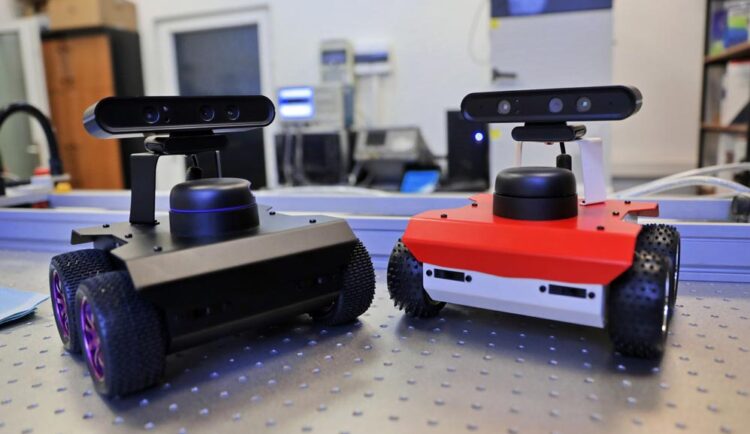They’ll lead the robots out

Husarion ROSbot 2.0 PRO and Husarion ROSbot 2.0
fot. Andrzej Romański
Why when walking in the city we do not enter blind alleys, or at least it happens to us very rarely, rather only when we lose our train of thought?
Thanks to our perception (i.e., seeing appropriate signs and assessing distances) we are able to predict that there is an obstacle in front of us – we do not have to check it at all while walking to the end of the street. We are able to move onto the right track at the right moment, without having to waste time turning back.
This is exactly the behavior we based on when developing the path planning algorithm that allows mobile robots to avoid dead ends – explains dr habil. Tomasz Tarczewski, NCU Prof. from the Institute of Engineering and Technology.
In addition to Prof. Tomasz Tarczewski, the team working on the algorithm includes mgr inz. Rafal Szczepanski, and inz. Artur Bereit, from the Institute of Engineering and Technology (a part of the Faculty of Physics, Astronomy and Informatics at the Nicolaus Copernicus University). They received a grant for their research in the INCOOP competition as part of the Excellence Initiative – Research University. The results have been published in the prestigious journal “Energies” in the article “Efficient Local Path Planning Algorithm Using Artificial Potential Field Supported by Augmented Reality“.
Why did they take an interest and decide to solve this particular problem?
Nowadays mobile robots are becoming more and more common in warehouses and production halls. Despite special routes, master algorithms coordinating the work of many robots in one hall, it may happen that the path of the robot will be blocked. Their main problem is that they often run into so-called dead ends – says Prof. Tarczewski. – And yet a collision-free passage is essential for the safety of the production cycle.
One way to solve this problem is to implement local path planning algorithms to ease the avoidance of various types of obstacles. Thanks to them, it is possible for the robot to autonomously unblock itself and continue its route.
– The principle of operation of most of these mechanisms involves the introduction of an additional algorithm leading the robot out of a dead end. In such an approach, the distance travelled by the mobile robot increases due to the necessity of retreating and causes unnecessary power consumption – explains Rafal Szczepanski. – For this purpose, we have applied a LiDAR sensor, i.e., a laser scanner providing information on distances from obstacles around the robot.
Then, based on the readings, the team of researchers at the Institute of Engineering and Technology developed a dead-end prediction mechanism: the robot compares real-time information about the available space with its own dimensions and makes a decision about passability based on that information. In order for the robot to give up exploring the impassable section, it must be provided with a mechanism to bypass it.
For this task, the researchers used augmented reality technology (AR for short).
In very general terms, it is the creation of additional virtual objects and adding them to reality. This technology is commonly used in various applications on smartphones, tablets, such as mobile games, photo and video apps and educational toys – says Artur Bereit.
Precisely how do you program the dead-end entry blocking mechanism into the robot?
Its reality should be extended with a virtual wall that will prevent it from passing. When a dead end is detected, a virtual wall is created as well as an additional obstacle on the left or right side of the robot in order to guide it in the right direction – explains Rafal Szczepanski. – It is this innovative and interdisciplinary combination of mobile robotics and augmented reality technology that allowed us to publish the results of our research in the journal “Energies”.
The team of researchers from our university implemented the developed algorithm of the potential fields method supported by augmented reality technology in the mobile robot Husarion ROSbot 2.0 PRO and conducted a series of laboratory tests to demonstrate the effectiveness of the proposed solution. The results are very promising – the researchers demonstrated a significant improvement in the properties of the potential fields algorithm commonly used in mobile robotics.
Journal: Energies
Method of Research: Experimental study
Subject of Research: Not applicable
Article Title: Efficient Local Path Planning Algorithm Using Artificial Potential Field Supported by Augmented Reality
Article Publication Date: 14-Sep-2021
Media Contact
Żaneta Kopczyńska
Nicolaus Copernicus University in Torun
zaneta.kopczynska@umk.pl
Expert Contact
Tomasz Tarczewski
NCU Torun
ttarczewski@fizyka.umk.pl
Office: +48 56 611 2439
Original Source
All latest news from the category: Power and Electrical Engineering
This topic covers issues related to energy generation, conversion, transportation and consumption and how the industry is addressing the challenge of energy efficiency in general.
innovations-report provides in-depth and informative reports and articles on subjects ranging from wind energy, fuel cell technology, solar energy, geothermal energy, petroleum, gas, nuclear engineering, alternative energy and energy efficiency to fusion, hydrogen and superconductor technologies.
Newest articles

Largest magnetic anisotropy of a molecule measured at BESSY II
At the Berlin synchrotron radiation source BESSY II, the largest magnetic anisotropy of a single molecule ever measured experimentally has been determined. The larger this anisotropy is, the better a…

Breaking boundaries: Researchers isolate quantum coherence in classical light systems
LSU quantum researchers uncover hidden quantum behaviors within classical light, which could make quantum technologies robust. Understanding the boundary between classical and quantum physics has long been a central question…

MRI-first strategy for prostate cancer detection proves to be safe
Active monitoring is a sufficiently safe option when prostate MRI findings are negative. There are several strategies for the early detection of prostate cancer. The first step is often a…



